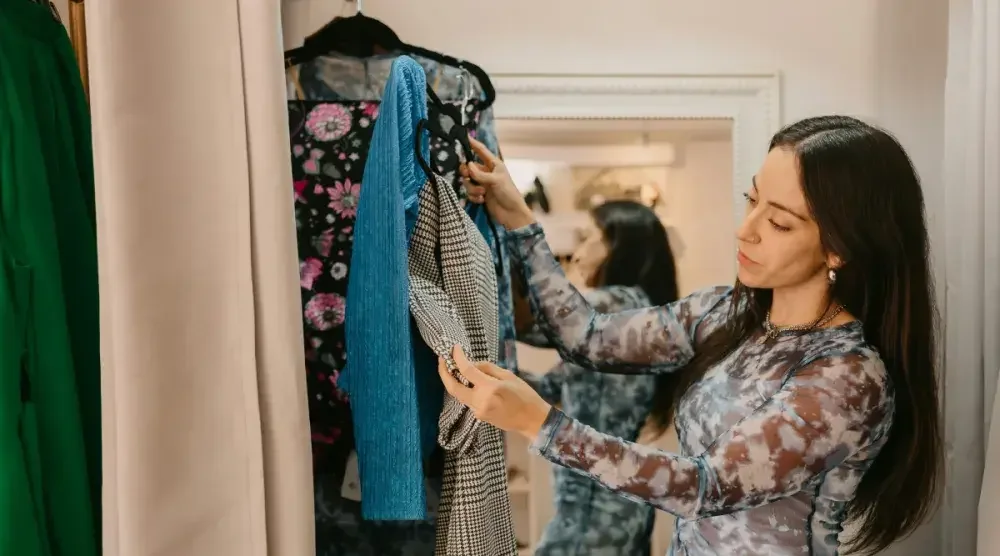Impressions matter. It's entirely possible to express your personal style and still dress properly. Your court attire can impact how judges, juries, and others perceive your respect for the legal process before your court proceedings even begin. Wouldn't you want to make the best impression possible?

Why courtroom attire matters
Your court appearance is about more than whether or not you "dress appropriately;" it's about demonstrating to judges and other court officials that you respect the court system and that you're taking them and the matter seriously.
Courtrooms often have their own specific dress code. If you wear clothes that meet their standards, it proves that you've done your research. Check the website of the court where your trial is being held or consult an attorney to learn your court's dress code.
General courtroom attire guidelines
- Choose neutral colors like black, navy blue, gray, or brown
- Wear a white dress shirt or blouse
- Wear dress shoes
- Wear dress slacks or a long/knee-length skirt
- Opt for modest dress
- Don't wear short skirts
- Don't wear bright colors
- Dress conservatively
- Don't wear jeans
- Avoid casual attire
- Avoid casual attire
- Avoid flashy jewelry
- Research your local courtroom dress code
Dress with respect
The number one tip is to dress in a way that demonstrates your respect for the courtroom, the legal process, and others’ time. Whether you're there to contest a speeding ticket or for a personal injury settlement, people have gathered in the court to hear your trial. Acknowledging that through your choice of clothing will only help your case.
This means avoiding casual items like jeans, sweatpants, T-shirts, sneakers, or flip-flops. Garments with holes or stains will tell the court that you're not taking this seriously. Instead, make a positive fashion statement by opting for business casual or more conservative dress. Closed-toe dress shoes, dress pants, button-down shirts, or business suits or jackets look sharp and signify that you respect the judicial process.
Conservative colors
Research in color theory has continued to grow in the last decade, corroborating that your choice of color may also determine how you're received during legal proceedings. Avoid bright and loud colors or patterns that can draw unwanted attention and distract from the matter at hand.
Whether you believe in color theory or not, courtrooms are formal settings. Neutral, subdued tones—such as black, navy, gray, white, brown, or blue—convey a solemn manner that's appropriate for attending court.
No revealing clothing
While you should feel free to dress in a way that feels comfortable and authentic to you in your daily life, dressing appropriately for court is about meeting the situation. Just as you would wear business attire to work, it's important to maintain courtroom etiquette by avoiding revealing clothing, such as low-cut tops, shorts, sleeveless, or anything exposing undergarments. This is equally true for men and women.
Neat grooming and accessories
In the same way that trimmed, well-fitting clothing is recommended for court appearances, neat grooming and accessories also show respect for the legal system by showing that you put effort into your courtroom appearance.
Clean, well-groomed hair, simple makeup, and neatly trimmed nails reflect consideration for yourself as well as everyone else who came to court to hear your case. If you have long hair, consider styling it back to keep it out of your face. Keep accessories to a minimum and remove any facial piercings for the few hours that you're in court.
What to wear to court: Women
The guidelines for what to wear to court for women and men are relatively the same with some variation. In terms of clothing, a collared shirt or blouse paired with conservative trousers, pantsuits, or a modest skirt is a smart choice that shows consideration for the court's decorum. If you prefer dresses, opt for something that you'd typically wear as professional attire, think first-time interview.
For shoes, closed-toe shoes—like flats or boots—are always the way to go. If you do decide to wear a heel, pick one of your more moderate heels in a neutral, single color. Again, avoid snakeskin or any other flashy designs, patterns, or colors.
We recommend wearing minimal jewelry and light makeup. A polished, understated style demonstrates that you made an effort, but you're still aware of the weight of a court setting. Brush and pull back any hair that could fall in your face. If you wear your hair in braids, get them freshly plaited. Ensuring your face is easily visible, and your voice clear and audible will make a positive impression.
What to wear to court: Men
Again, it can be difficult to create clear-cut lines between what men vs. women should wear to court, so excuse the overlap. Depending on your case, it's equally appropriate to wear a suit and tie or more of a business-casual button-down shirt and tailored slacks.
For example, if you don't have a suit, a sports coat paired with a collared shirt and khakis will give an equally considered impression. If you don't wear a coat, make sure to choose a dress shirt that covers your arms.
While Crocs may be extremely ideal for running errands, they're not appropriate for court. Dark leather shoes—or other formal closed-toe shoes—will serve you much better. Keep your hair neat, facial hair trimmed, and avoid excessive jewelry.
If you have long hair, consider tying it back. If your hair is mid-length and loose, consider slicking it back with a gel. If you wear your hair in braids, consider getting them freshly plaited close to your court date. These little touches will go a long way to show you're taking the legal system seriously.
What not to wear to court
While some of this is covered above, here's a quick breakdown of what not to wear to court.
Casual or athletic wear
You don't want to give the impression that you fit your court appearance around your daily errands, such as grocery shopping or going to the gym. Avoid shorts, sweatpants, T-shirts, athletic wear, pajamas, or any other casual attire that could give that impression.
Revealing or distracting outfits
Dressing appropriately for court is about meeting a solemn occasion with an ensemble that fits the mood and the purpose of the event. All genders should avoid showing too much skin or wearing flashy outfits or accessories to demonstrate appropriate consideration for the legal proceeding and everyone involved.
Logos and graphics
In the same vein as above, a graphic T-shirt with offensive or controversial logos, images, or slogans is highly discouraged. Even when not offensive, shirts with phrases and other prints can be distracting and informal. More people come to court in this style of attire than you'd think, and it doesn't benefit them.
Strong scents
Scents are a subtle, but important element of how you represent yourself in court. The courtroom is an enclosed space, which can enhance the impact of scents. Strong scents can also elicit an emotional response due to the connection between smell and memory.
To avoid strong scents, refrain from using a strong cologne, perfume, or body spray. Keeping deodorant wipes in your bag, backpack, or briefcase is a quick and easy way to freshen up before your courtroom appointment.
Hats
As the courtroom is indoors, it's best to avoid baseball caps, knit hats, or any other hats as they can be seen as overly casual and disrespectful to the court and those involved. Additionally, hats can obscure your face. It's important to ensure your face is clearly visible during court proceedings as this shows that you have confidence in yourself and your case.
FAQs
Do I have to wear a suit to court?
No, you don't have to wear a suit to court although it doesn't hurt to look extra sharp. Especially in family court, a dress shirt, tailored slacks, and dress shoes will also demonstrate that you put adequate consideration into your courtroom appearance.
What should children wear to court?
The dress code for children in court is relatively similar to what it is for adults. Neutral colors, formal attire, and closed-toe dress shoes with socks will make a positive impression in court. Bikini straps, shorts, and sandals are ideal for the beach, but modest coverage at court is about meeting the seriousness of the moment with suitable attire.
What should I wear to court as an observer?
The same dress codes apply to observers as to defendants and plaintiffs. If you're an observer at court, you're likely there to support someone involved in the legal proceedings. Dressing appropriately in neutral colors and conservative dress will reflect positively on your loved one.

